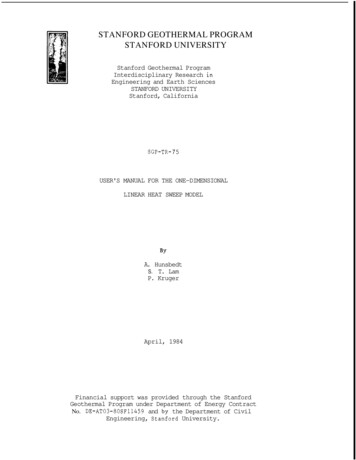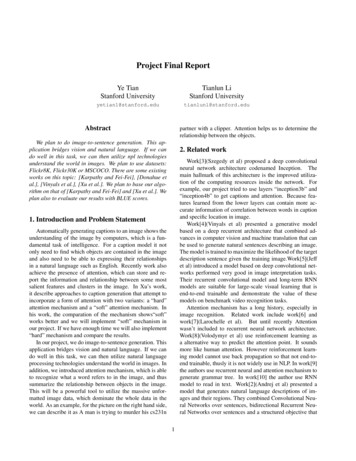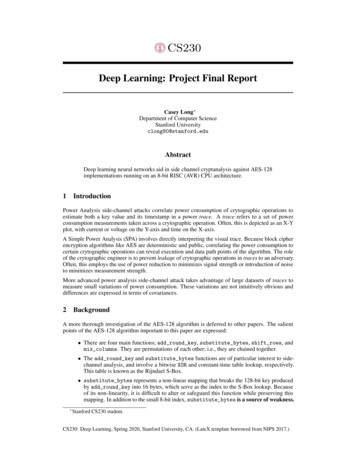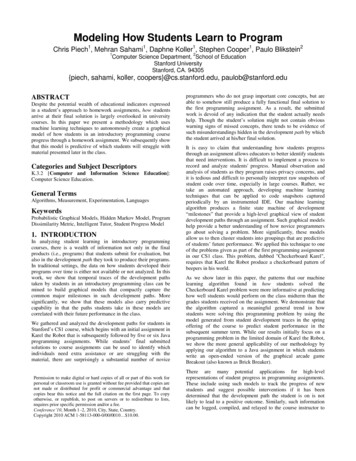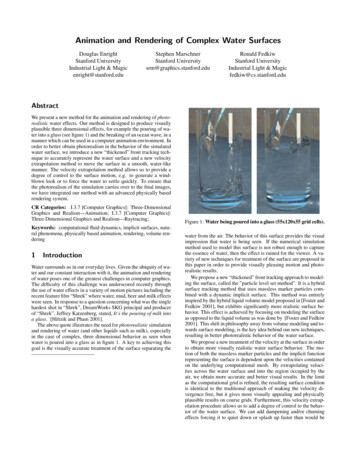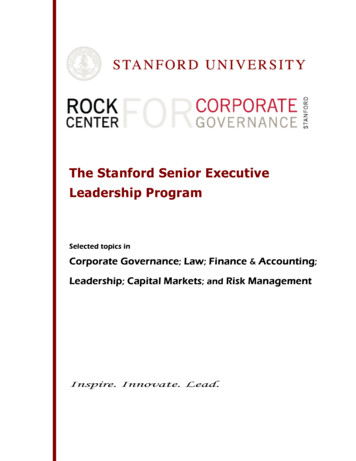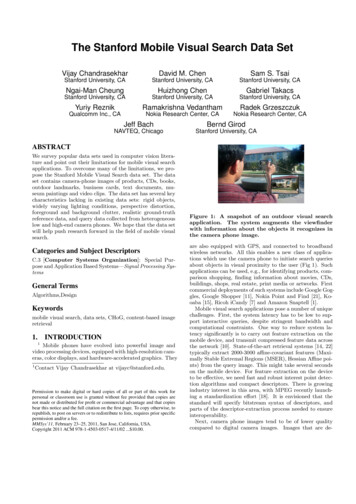
Transcription
The Stanford Mobile Visual Search Data SetVijay ChandrasekharDavid M. ChenSam S. TsaiStanford University, CAStanford University, CAStanford University, CANgai-Man CheungHuizhong ChenGabriel TakacsStanford University, CAStanford University, CAStanford University, CAYuriy ReznikRamakrishna VedanthamRadek GrzeszczukQualcomm Inc., CANokia Research Center, CANokia Research Center, CAJeff BachBernd GirodNAVTEQ, ChicagoStanford University, CAABSTRACTWe survey popular data sets used in computer vision literature and point out their limitations for mobile visual searchapplications. To overcome many of the limitations, we propose the Stanford Mobile Visual Search data set. The dataset contains camera-phone images of products, CDs, books,outdoor landmarks, business cards, text documents, museum paintings and video clips. The data set has several keycharacteristics lacking in existing data sets: rigid objects,widely varying lighting conditions, perspective distortion,foreground and background clutter, realistic ground-truthreference data, and query data collected from heterogeneouslow and high-end camera phones. We hope that the data setwill help push research forward in the field of mobile visualsearch.Categories and Subject DescriptorsC.3 [Computer Systems Organization]: Special Purpose and Application Based Systems—Signal Processing SystemsGeneral TermsAlgorithms,DesignKeywordsmobile visual search, data sets, CHoG, content-based imageretrieval1. INTRODUCTION1Mobile phones have evolved into powerful image andvideo processing devices, equipped with high-resolution cameras, color displays, and hardware-accelerated graphics. They1Contact Vijay Chandrasekhar at vijayc@stanford.edu.Permission to make digital or hard copies of all or part of this work forpersonal or classroom use is granted without fee provided that copies arenot made or distributed for profit or commercial advantage and that copiesbear this notice and the full citation on the first page. To copy otherwise, torepublish, to post on servers or to redistribute to lists, requires prior specificpermission and/or a fee.MMSys’11, February 23–25, 2011, San Jose, California, USA.Copyright 2011 ACM 978-1-4503-0517-4/11/02 . 10.00.Figure 1: A snapshot of an outdoor visual searchapplication. The system augments the viewfinderwith information about the objects it recognizes inthe camera phone image.are also equipped with GPS, and connected to broadbandwireless networks. All this enables a new class of applications which use the camera phone to initiate search queriesabout objects in visual proximity to the user (Fig 1). Suchapplications can be used, e.g., for identifying products, comparison shopping, finding information about movies, CDs,buildings, shops, real estate, print media or artworks. Firstcommercial deployments of such systems include Google Goggles, Google Shopper [11], Nokia Point and Find [21], Kooaba [15], Ricoh iCandy [7] and Amazon Snaptell [1].Mobile visual search applications pose a number of uniquechallenges. First, the system latency has to be low to support interactive queries, despite stringent bandwidth andcomputational constraints. One way to reduce system latency significantly is to carry out feature extraction on themobile device, and transmit compressed feature data acrossthe network [10]. State-of-the-art retrieval systems [14, 22]typically extract 2000-3000 affine-covariant features (Maximally Stable Extremal Regions (MSER), Hessian Affine points) from the query image. This might take several secondson the mobile device. For feature extraction on the deviceto be effective, we need fast and robust interest point detection algorithms and compact descriptors. There is growingindustry interest in this area, with MPEG recently launching a standardization effort [18]. It is envisioned that thestandard will specify bitstream syntax of descriptors, andparts of the descriptor-extraction process needed to ensureinteroperability.Next, camera phone images tend to be of lower qualitycompared to digital camera images. Images that are de-
graded by motion blur or poor focus pose difficulties forvisual recognition. However, image quality is rapidly improving with higher resolution, better optics and built-inflashes on camera phones.Outdoor applications pose additional challenges. Currentretrieval systems work best for highly textured rigid planarobjects taken under controlled lighting conditions. Landmarks, on the other hand, tend to have fewer features, exhibit repetitive structures and their 3-D geometric distortions are not captured by simple affine or projective transformations. Ground truth data collection is more difficult,too. There are different ways of bootstrapping databasesfor outdoor applications. One approach is to mine datafrom online collections like Flickr. However, these imagestend to be poorly labelled, and include a lot of clutter. Another approach is to harness data collected by companies likeNavteq, Google (StreetView) or Earthmine. In this case,the data are acquired by vehicle-mounted powerful cameraswith wide-angle lenses to capture spherical panoramic images. In both cases, visual recognition is challenging becausethe camera phone query images are usually taken under verydifferent lighting conditions compared to reference databaseimages. Buildings and their surroundings (e.g., trees) tendto look different in different seasons. Shadows, pedestriansand foreground clutter are some of the other challenges inthis application domain.OCR on mobile phones enables another dimension of applications, from text input to text-based queries to a database. OCR engines work well on high quality scanned images. However, the performance of mobile OCR drops rapidlyfor images that are out of focus and blurry, have perspectivedistortion or non-ideal lighting conditions.To improve performance of mobile visual search applications, we need good data sets that capture the most commonproblems that we encounter in this domain. A good data setfor visual search applications should have the following characteristics: Should have good ground truth reference images Should have query images with a wide range of cameraphones (flash/no-flash, auto-focus/no auto-focus) Should be collected under widely varying lighting conditions Should capture typical perspective distortions, motionblur, foreground and background clutter common to mobile visual search applications. Should represent different categories (e.g., buildings, books,CDs, DVDs, text documents, products) Should contain rigid objects so that a transformation canbe estimated between the query and reference databaseimage.We surveyed popular data sets in the computer vision literature, and observed that they were all limited in differentways. To overcome many of the limitations in existing datasets, we propose the Stanford Mobile Visual Search (SMVS)data set that we hope will help move research forward inthis field. In Section 2, we survey popular computer visiondata sets, and point out their limitations. In Section 3, wepropose the SMVS data set for different mobile visual searchapplications.2.SURVEY OF DATA SETSPopular computer vision data sets for evaluating image retrieval algorithms consist of a set of query images and theirground truth reference images. The number of query imagestypically range from a few hundred to a few thousand. Thescalability of the retrieval methods is tested by retrievingthe query images in the presence of “distractor” images, orimages that do not belong to the data set [14, 22]. The “distractor” images are typically obtained by mining Flickr orother photo sharing websites. Here, we survey popular datasets in computer vision literature and discuss their limitations for our application. See Fig. 2 for examples from eachdata set, and Tab. 1 for a summary of the different datasets.ZuBuD.The Zurich Building (ZuBuD) dataset [12] consists of 201buildings in Zurich, with 5 views of each building. There are115 query images which are not contained in the database.Query and database images differ in viewpoint, but variations in illumination are rare because the different images forthe same building are taken at the same time of day. TheZuBuD is considered an easy data set, with close to 100%accuracy being reported in several papers [13, 24]. Simpleapproaches like color histograms and descriptors based onDCT [24] yield high performance for this dataset.Oxford Buildings.The Oxford Buildings Datset [22] consists of 5062 images collected from Flickr by searching for particular Oxfordlandmarks. The collection has been manually annotated togenerate a comprehensive ground truth for 11 different landmarks, each represented by 5 possible queries. This givesonly a small set of 55 queries. Another problem with thisdata set is that completely different views of the same building are labelled by the same name. Ideally, different facadesof each building should be distinguished from each other,when evaluating retrieval performance.INRIA Holidays.The INRIA Holidays dataset [14] is a set of images whichcontains personal holiday photos of the authors in [14]. Thedataset includes a large variety of outdoor scene types (natural, man-made, water and fire effects). The dataset contains500 image groups, each of which represents a distinct sceneor object. The data set contains perspective distortions andclutter. However, variations in lighting are rare as the pictures are taken at the same time from each location. Also,the data set contains scenes of many non-rigid objects (fire,beaches, etc), which will not produce repeatable features, ifimages are taken at different times.University of Kentucky.The University of Kentucky (UKY) [20] consists of 2550groups of 4 images each of objects like CD-covers, lamps,keyboards and computer equipment. Similar to ZuBuD andINRIA data sets, this data set also offers little variationin lighting conditions. Further, there is no foreground orbackground clutter with only the object of interest presentin each image.Image Net.The ImageNet dataset [6] consists of images organized bynouns in the WordNet hierarchy [8]. Each node of the hierarchy is depicted by hundreds and thousands of images. E.g.,
ZuBuDOxfordINRIAUKYImage NetsFigure 2: Limitations with popular data sets in computer vision. The left most image in each row is thedatabase image, and the other 3 images are query images. ZuBuD, INRIA and UKY consist of images takenat the same time and location. ImageNets is not suitable for image retrieval applications. The Oxford datasethas different faades of the same building labelled with the same name.Fig. 2 illustrates some images for the word “tiger”. Such adata set is useful for testing classification algorithms, butnot so much for testing retrieval algorithms.We summarize the limitations of the different data setsin Tab. 1. To overcome the limitations in these data sets,we propose the Stanford Mobile Visual Search (SMVS) dataset.3. STANFORD MOBILE VISUAL SEARCHDATA SETWe present the SMVS (version 0.9) data set in the hopethat it will be useful for a wide range of visual search applications like product recognition, landmark recognition, outdoor augmented reality [26], business card recognition, textrecognition, video recognition and TV-on-the-go [5]. We collect data for several different categories: CDs, DVDs, books,software products, landmarks, business cards, text documents, museum paintings and video clips. Sample queryand database images are shown in Figure 4. Current andsubsequent versions of the dataset will be available at [3].The number of database and query images for differentcategories is shown in Tab. 2. We provide a total 3300 queryimages for 1200 distinct classes across 8 image categories.Typically, a small number of query images ( 1000s) suffice to measure the performance of a retrieval system as therest of the database can be padded with “distractor” images.Ideally, we would like to have a large distractor set for eachquery category. However, it is challenging to collect distractor sets for each category. Instead, we plan to release twodistractor sets upon request: one containing Flickr images,and the other containing building images from Navteq. Thedistractor sets will be available in sets of 1K, 10K, 100K and1M. Researchers can test scalability using these distractordata sets, or the ones provided in [22, 14]. Next, we discusshow the query and reference database images are collected,and evaluation measures that are in particular relevant formobile applications.Reference Database Images.For product categories (CDs, DVDs and books), the references are clean versions of images obtained from the productwebsites. For landmarks, the reference images are obtainedfrom data collected by Navteq’s vehicle-mounted cameras.For video clips, the reference images are the key frame fromthe reference video clips. The videos contain diverse contentlike movie trailers, news reports, and sports. For text documents, we collect (1) reference images from [19], a websitethat mines the front pages of newspapers from around theworld, and (2) research papers. For business cards, the reference image is obtained from a high quality upright scanof the card. For museum paintings, we collect data fromthe Cantor Arts Center at Stanford University for different genres: history, portraits, landscapes and modern-art.The reference images are obtained from the artists’ websiteslike [23] or other online sources. All reference images arehigh quality JPEG compressed color images. The resolutionof reference images varies for each category.Query Images.We capture query images with several different cameraphones, including some digital cameras. The list of companies and models used is as follows: Apple (iPhone4), Palm(Pre), Nokia (N95, N97, N900, E63, N5800, N86), Motorola(Droid), Canon (G11) and LG (LG300). For product cate-
erspective CameraPhone Table 1: Comparison of different data sets. “Classes” refers to the number of distinct objects in the data set.“Rigid” refers to whether on not the objects in the database are rigid. “Lighting” refers to whether or notthe query images capture widely varying lighting conditions. “Clutter” refers to whether or not the queryimages contain foreground/background clutter. “Perspective” refers to whether the data set contains typicalperspective distortions. “Camera-phone” refers to whether the images were captured with mobile devices.SMVS is a good data set for mobile visual search applications.gories like CDs, DVDs, books, text documents and businesscards, we capture the images indoors under widely varyinglighting conditions over several days. We include foregroundand background clutter that would be typically present inthe application, e.g., a picture of a CD would might otherCDs in the background. For landmarks, we capture imagesof buildings in San Francisco. We collected query imagesseveral months after the reference data was collected. Forvideo clips, the query images were taken from laptop, computer and TV screens to include typical specular distortions.Finally, the paintings were captured at the Cantor Arts Center at Stanford University under controlled lighting conditions typical of museums.The resolution of the query images varies for each cameraphone. We provide the original JPEG compressed high quality color images obtained from the camera. We also provideauxiliary information like phone model number, and GPSlocation, where applicable. As noted in Tab. 1, the SMVSquery data set has the following key characteristics that islacking in other data sets: rigid objects, widely varying lighting conditions, perspective distortion, foreground and background clutter, realistic ground-truth reference data, andquery images from heterogeneous low and high-end cameraphones.CategoryCDDVDBooksVideo ClipsLandmarksBusiness CardsText Query400400400400500400400400Table 2: Number of query and database images inthe SMVS data set for different categories.Evaluation measures.A naive retrieval system would match all database images against each query image. Such a brute-force matching scheme provides as an upper-bound on the performancethat can be achieved with the feature matching pipeline.Here, we report results for brute-force pairwise matchingfor different interest point detectors and descriptors usingthe ratio-test [16] and RANSAC [9]. For RANSAC, we useaffine models with a minimum threshold of 10 matches postRANSAC for declaring a pair of images to be a valid match.In Fig. 3, we report results for 3 state-of-the-art schemes:(1) SIFT Difference-of-Gaussian (DoG) interest point detector and SIFT descriptor (code: [27]), (2) Hessian-affineinterest point detector and SIFT descriptor (code [17]), and(3) Fast Hessian blob interest point detector [2] sped upwith integral images, and the recently proposed CompressedHistogram of Gradients (CHoG) descriptor [4]. We reportthe percentage of images that match, the average numberof features and the average number of features that matchpost-RANSAC for each category.First, we note that indoor categories are easier than outdoor categories. E.g., some categories like CDs, DVDs andbook covers achieve over 95% accuracy. The most challenging category is landmarks as the query data is collected several months after the database.Second, we note that option (1): SIFT interest point detector and descriptor, performs the best. However, option(1) is computationally complex and is not suitable for implementation on mobile devices.Third, we note that option (3) performs comes close toachieving the performance of (1), with worse performance(10-20% drop) for some categories. The performance hit isincurred due to the fast Hessian-based interest point detector, which is not as robust as the DoG interest point detector. One reason for lower robustness is observed in [25]: thefast box-filtering step causes the interest point detection tolose rotation invariance which affects oriented query images.The CHoG descriptor used in option (3) is a low-bitrate 60bit descriptor which is shown to perform on par with the128-dimensional 1024-bit SIFT descriptor using extensiveevaluation in [4]. We note that option (3) is most suitablefor implementation on mobile devices as the fast hessian interest point detector is an order-of-magnitude faster thanSIFT DoG, and the CHoG descriptors generate an orderof magnitude less data than SIFT descriptors for efficienttransmission [10].Finally, we list aspects critical for mobile visual searchapplications. A good image retrieval system should exhibitthe follow characteristics when tested on the SMVS dataset. High Precision-Recall as size of database increases Low retrieval latency
1003501200Avg. # Matches Post RANSAC1100100090080Avg. # FeaturesImage Match Accuracy (%)90706050800700600500400DoG SIFTHessian Affine SIFTFast Hessian CHoG40DVDs Videos BooksCDsPrints300CardsArt LandmarksDoG SIFTHessian Affine SIFTFast Hessian CHoG200DVDs Videos Books(a)CDs(b)300DoG SIFTHessian Affine SIFTFast Hessian CHoG25020015010050PrintsCardsArt Landmarks0DVDs Videos BooksCDsPrintsCardsArt Landmarks(c)Figure 3: Results for each category (PR Post RANSAC). We note that indoor categories like CDs areeasier than outdoor categories like landmarks. Books, CD covers, DVD covers and video clips achieve over95% accuracy. Fast pre-processing algorithms for improving image quality Fast and robust interest point detection Compact feature data for efficient transmission and storage4. SUMMARYWe survey popular data sets used in computer vision literature and note that they are limited in many ways. We propose the Stanford Mobile Visual Search data set to overcomeseveral of the limitations in existing data sets. The SMVSdata set has several key characteristics lacking in existingdata sets: rigid objects, several categories of objects, widelyvarying lighting conditions, perspective distortion, typicalforeground and background clutter, realistic ground-truthreference data, and query data collected from heterogeneouslow and high-end camera phones. We hope that this data setwill help push research forward in the field of mobile visualsearch.5. REFERENCES[1] Amazon. SnapTell, 2007. http://www.snaptell.com.[2] H. Bay, T. Tuytelaars, and L. V. Gool. SURF: Speeded UpRobust Features. In Proc. of European Conference onComputer Vision (ECCV), Graz, Austria, May 2006.[3] V. Chandrasekhar, D.M.Chen, S.S.Tsai, N.M.Cheung, H.Chen,G.Takacs, Y.Reznik, R.Vedantham, R.Grzeszczuk, J.Back, andB.Girod. Stanford Mobile Visual Search Data Set, 2010.http://mars0.stanford.edu/mvs images/.[4] V. Chandrasekhar, G. Takacs, D. M. Chen, S. S. Tsai,R. Grzeszczuk, Y. Reznik, and B. Girod. CompressedHistogram of Gradients: A Low Bitrate Descriptor. InInternational Journal of Computer Vision, Special Issue onMobile Vision, 2010. under review.[5] D. M. Chen, N. M. Cheung, S. S. Tsai, V. Chandrasekhar,G. Takacs, R. Vedantham, R. Grzeszczuk, and B. Girod.Dynamic Selection of a Feature-Rich Query Frame for MobileVideo Retrieval. In Proc. of IEEE International Conferenceon Image Processing (ICIP), Hong Kong, September 2010.[6] J. Deng, W. Dong, R. Socher, L. Li, K. Li, and L. Fei-Fei.Imagenet: A large-scale hierarchical image database. In Proc.of IEEE Conference on Computer Vision and PatternRecognition (CVPR), Miami, Florida, June 2009.[7] B. Erol, E. Antúnez, and J. Hull. Hotpaper: multimediainteraction with paper using mobile phones. In Proc. of the16th ACM Multimedia Conference, New York, NY, USA, 2008.[8] C. Fellbaum. WordNet: An Electronic Lexical Database.Bradford Books, 1998.[9] M. A. Fischler and R. C. Bolles. Random Sample Consensus: Aparadigm for model fitting with applications to image analysisand automated cartography. Communications of ACM,24(6):381–395, 1981.[10] B. Girod, V. Chandrasekhar, D. M. Chen, N. M. Cheung,R. Grzeszczuk, Y. Reznik, G. Takacs, S. S. Tsai, andR. Vedantham. Mobile Visual Search. In IEEE SignalProcessing Magazine, Special Issue on Mobile Media Search,2010. under review.[11] Google. Google Goggles, 2009.http://www.google.com/mobile/goggles/.[12] L. V. G. H.Shao, T. Svoboda. Zubud-Zürich buildings databasefor image based recognition. Technical Report 260, ETHZürich, 2003.[13] S. J. Matas. Sub-linear indexing for large scale objectrecognition. In Proc. of British Machine Vision Conference(BMVC), Oxford, UK, June 2005.[14] H. Jegou, M. Douze, and C. Schmid. Hamming embedding andweak geometric consistency for large scale image search. InProc. of European Conference on Computer Vision (ECCV),Berlin, Heidelberg, 2008.[15] Kooaba. Kooaba, 2007. http://www.kooaba.com.[16] D. Lowe. Distinctive image features from scale-invariantkeypoints. International Journal of Computer Vision,60(2):91–110, 2004.[17] K. Mikolajczyk. Software for computing Hessian-affineinterest points and SIFT descriptor, 2010.http://lear.inrialpes.fr/ jegou/data.php.[18] MPEG. Requirements for compact descriptors for visual search.In ISO/IEC JTC1/SC29/WG11/W11531, Geneva,Switzerland, July 2010.[19] Newseum. Newseum. name CA MSS&ref pge gal&b pge 1.[20] D. Nistér and H. Stewénius. Scalable recognition with avocabulary tree. In Proc. of IEEE Conference on ComputerVision and Pattern Recognition (CVPR), New York, USA,June 2006.[21] Nokia. Nokia Point and Find, 2006.http://www.pointandfind.nokia.com.[22] J. Philbin, O. Chum, M. Isard, J. Sivic, and A. Zisserman.Object Retrieval with Large Vocabularies and Fast SpatialMatching. In Proc. of IEEE Conference on Computer Visionand Pattern Recognition (CVPR), Minneapolis, Minnesota,2007.[23] W. T. Richards. William Trot Richards: The CompleteWorks. http://www.williamtrostrichards.org/.[24] J. M. S.Obdrzalek. Image retrieval using local compactdct-based representation. In Proc. of the 25th DAGMSymposium, Magdeburg, Germany, September 2003.[25] G. Takacs, V. Chandrasekhar, H. Chen, D. M. Chen, S. S. Tsai,R. Grzeszczuk, and B. Girod. Permutable Descriptors forOrientation Invariant Matching. In Proc. of SPIE Workshopon Applications of Digital Image Processing (ADIP), SanDiego, California, August 2010.[26] G. Takacs, V. Chandrasekhar, N. Gelfand, Y. Xiong, W. Chen,T. Bismpigiannis, R. Grzeszczuk, K. Pulli, and B. Girod.Outdoors augmented reality on mobile phone using loxel-basedvisual feature organization. In Proc. of ACM InternationalConference on Multimedia Information Retrieval (ACMMIR), Vancouver, Canada, October 2008.[27] A. Vedaldi and B. Fulkerson. VLFeat: An open and portablelibrary of computer vision algorithms, 2008.http://www.vlfeat.org/.
CDsDVDsBooksLandmarksVideo ClipsCardsPrintPaintingsFigure 4: Stanford Mobile Visual Search (SMVS) data set. The data set consists of images for many differentcategories captured with a variety of camera-phones, and under widely varying lighting conditions. Databaseand query images alternate in each category.
mobile device, and transmit compressed feature data across the network [10]. State-of-the-art retrieval systems [14, 22] typically extract 2000-3000 affine-covariant features (Maxi-mally Stable Extremal Regions (MSER), Hessian Affine poi-nts) from the query image. This might take several seconds on the mobile device. For feature extraction on .
